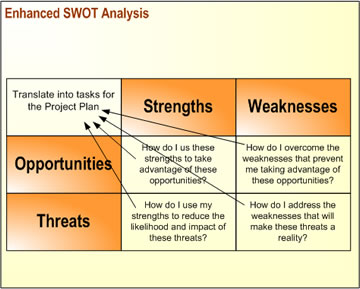If a business is intending to tack some type of action they will not want to go in to this blind. This would involve too much risk so the safest approach would be to do a bit of research first. SWOT analysis involves closely examining the strengths, weaknesses, opportunities, and threats involved in any plan. This tool is used by most businesses and organizations that are serious about increasing the likelihood of success for their plans. This type of analysis provides information about the strengths and weaknesses of any plan. Once this information is known it is possible to proceed with a lot more confidence.
Elements of SWOT Analysis
 The four elements of SWOT analysis are:
The four elements of SWOT analysis are:
Strengths: these are the elements that provide the team with an advantage when they implement their plan. For instance, if the team has members who are particularly skilled at the tasks needed for the project then this would be considered a strength.
Weakness: these are the elements that put the team at a disadvantage. So for example, if the team has no experience with this type or project before that could be a weakness.
Opportunities: these are the potential benefits of going ahead with the plan. If it is a marketing campaign then the opportunities could be a whole new audience for their product.
Threats: these are those elements that could threaten the business if they go ahead with their plan. A good example of a threat would be an advertising campaign that might alienate some customers. This happens a lot when a business tries to appeal to a target group (e.g. teenagers) and by doing so lose some of their more mature audience.
By closely looking at these four different areas the business will have a much clearer idea of what is involved in their plan.
How SWOT Analysis is Used in Practice
Just identifying the strengths and weaknesses of any plan is only half the battle when it comes to benefiting from this type of analysis. It will then be necessary to consider ways to increase the strengths while minimizing the weaknesses. All this is probably better understood by way of an example.
Imagine a small business that hopes to become successful selling uniquely designed fashionable t-shirts. They are planning a marketing campaign that focuses on the fact that their t-shirts are so reasonably priced as well as cool. Using the SWOT analysis they may find the following:
- Strengths: they will easily be able to increase production and offset any loss due to the drop in selling price.
- Weaknesses: their material supplier can sometimes be unreliable and this could hold up production.
- Opportunities: a whole new market of budget shoppers to buy their product.
- Threats: they could lose some of their more fussy customers who may be put off by the cheap price
Here the business could reduce their weaknesses and threats by finding a new supplier and continuing to focus on the uniqueness of their product. This may not remove the weaknesses altogether but it should reduce them.







